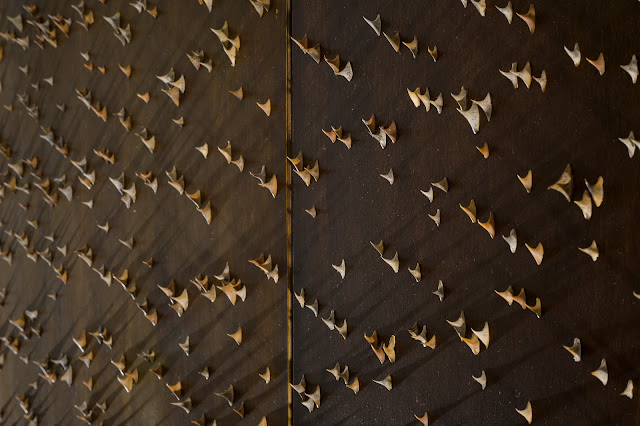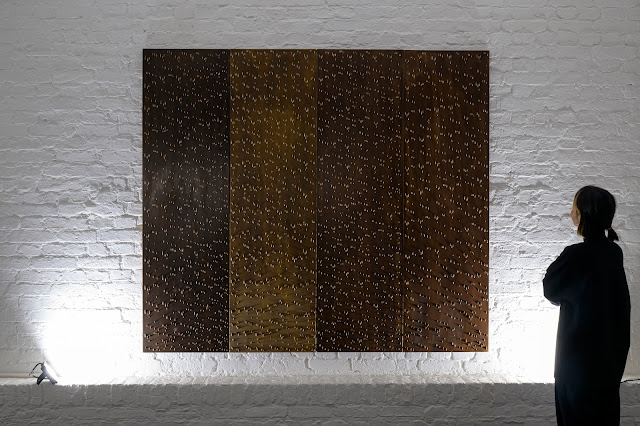Thorns (Urban nature series)
‘Thorns’
thorns of roses on wooden panel _ 200x150 cm _ 2021
 |
<Details> photo by Marc Doradzillo |
 |
| Installation view @ Soma Art Space 700, Berlin, 2021 |
 |
| ‘Harmony and Variation’ _ thorns of roses on paper _ 60 x 50cm _ 2021 |
All that remains and something that never disappears
plant thorns, the stems of a blackberry bush that has detached from its thorns, 2020
TWO DEGREES PLUS : A Multi-Disciplinary Exhibit 2020
Commissioned by Artrmx e.V.
 |
‘ALIVE’a sweater found in Vogelsang,where is once Russia’s hidden nuclear weapons facility in Berlin, 2021 |
The moss-covered sweater is a found object from the abandoned military base in Vogelsang. Between 1959 and 1962, the area was the nuclear missile base of Soviet Union in East Germany. As history tells, the order to load up the missiles never came and the base continuted to operate until the end of Cold War. From then on, the site is encapsulated in time but it is not altogether static. It absorbs anything that comes by to remain into its own fabric. This pre-owned sweater thus eventaully became the co-host for the site´s inhabitants.
Alive was developed during the pandemic when lockdown grounded the otherwise world travellers in situ. What followed was the voluntary and involuntary exploration of the cities for new routines and pastimes. The new ties to the city fostered as a result substan-tially change the way we relate to the micro- and macro-environment.
This work succinctly charts such in/evolvement process. The concept of the work translates into an ongoing labor of Luft und Liebe: air-holes on the top of the vitrine; watering and health check on the greens are added to the artist Jazoo Yang´s routine, for instance. Alive captures the transformation process of structural change - physical and behavioural, activated simply by a sense of duty of care.
- Text by Meanwhile Elsewhere / Agnus Tam 2021
 |
Artwork photo by Lutz Bertram Installation View @ Meanwhile Elsewhere/Soma Art Space 300, Berlin 2021 |
‘The Last Memory’
branches, sleeves of clothes_dimensions variable, 2021
Installation View @ Meanwhile Elsewhere/Soma Art Space 300, Berlin 2021
In Korea, tradition has it that those old trees are sacred because they are the dwelling place for God.
Even if the emotion that people felt toward the tree in the unfortunate event was fear, it was due to their respect for nature. Because they believed that their soul and nature were connected.
All this faith fades as time goes by. So, this work is kind of my last memory... It's about a time when people still respected nature."
 |
Artwork photo by Lutz Bertram Installation View @ Meanwhile Elsewhere/Soma Art Space 300, Berlin 2021 |
‘They are there’
Roots of various plants sewn on canvas, light _ 200x150 cm _ 2021
 |
| Installation view @ Soma Art Space 700, Berlin, 2021 |
TWO DEGREES PLUS : A Multi-Disciplinary Exhibit 2020
Commissioned by Artrmx e.V.
On small paths along the Hambach Forest, Jazoo Yang collects many sensual and often contradictory impressions. Deciduous trees, a crack somewhere very high up, a small branch falling to the ground. Birdsong, rustling leaves, the wind, a mossy, earthy smell or, beautiful mushroom formations. Fallen trees with their gigantic roots sticking up in the air, dead wood where insects cavort, and brambles. Tree houses and, bicycles, lovingly designed barricades by people who care about the forest and its preservation and who protect it. And then, at the very end of the forest, a huge hole appears out of nowhere, the Hambach open pit mine. The machines that excavate the lignite here day in and day out, even they are tiny compared to the vast empty wasteland that was forest not so long ago. The disappearance of entire landscapes can be seen precisely at this quarry edge - on one side, the green of the trees, and on the other, the gray-beige iridescent coal mining area.
Yang's installation 'NOW WHAT DO WE WISH FOR' incorporates all of these different impressions. They merge with the myths of the forest, with prehistoric handprint rituals as well as with the Korean ‘Seonangdang trees’ - very old, sacred trees that protect places, houses and people. What is left then, when more and more landscapes and forests are disappearing, little by little?
- Margrit Miebach, Director @ Artrmx e.V.
Installation view @ Artrmx e.V. / Photo by Pietro Viti
‘Evidence’
 |
| detail |
There’s always delightful discovery, sometimes through the microscope lends, that there are so many neighbors in my apartment block. For example, spiders and those nameless little plants seem to be happy to share our space.
That is less likely the case when it comes to people-to-people relationship. In Seoul, I spent my weekends breaking into cons- truction sites and painted on the walls of the to-be torn down buildings. (…)
(…)During these trespasses, I found that there were still residents remaining in their homes, actually living right at the construction site. They refused to move, nor did they have the money to. The compensation the land developers offered was not enough for them to relocate. A combination of reasons led me to the encounter between me in the transitory space and the people who have their life and living memory planted in that space.”
- Artist interview by Meanwhile Elsewhere/ Agnus Tam, May 2021
Artwork photography by Lutz Bertram















































